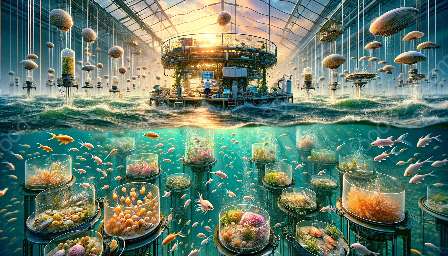Shellfish, a popular and valuable seafood, is harvested through various methods and undergoes intricate post-harvest processing to ensure quality and safety. This comprehensive guide explores the fascinating world of shellfish harvesting and post-harvest processing, intricately linking it with shellfish biology, aquaculture, and seafood science.
Shellfish Biology: Understanding the Underwater World
Before delving into the intricate process of harvesting and post-harvest processing, it's essential to understand the biological aspects of shellfish. Shellfish, a broad category encompassing mollusks and crustaceans, thrive in diverse aquatic environments, ranging from shallow coastal waters to deep-sea habitats.
Mollusks and Crustaceans: The two main categories of shellfish, mollusks, and crustaceans, exhibit unique biological features. Mollusks, including bivalves like oysters and clams, as well as gastropods like snails, possess distinct shell structures, while crustaceans, such as crabs and lobsters, boast exoskeletons providing protection and support.
Ecological Significance: Shellfish play a crucial role in marine ecosystems, acting as filter feeders, purifying surrounding waters by removing excess nutrients and contaminants. Additionally, these marine creatures serve as a vital food source for various marine predators, contributing to the complexity and balance of underwater food webs.
Aquaculture: Cultivating Shellfish for Sustainable Harvesting
With the increasing demand for shellfish, aquaculture has emerged as a sustainable and efficient method for cultivating these coveted seafood delicacies. By leveraging aquaculture practices, researchers and farmers can optimize shellfish production while minimizing environmental impact.
Integrated Farming Systems: Aquaculture facilities often implement integrated farming systems, utilizing natural marine habitats and artificial structures to create optimal conditions for shellfish growth. This approach not only enhances production efficiency but also promotes ecological sustainability, as it minimizes the need for additional resource inputs.
Efficient Feeding Strategies: In aquaculture settings, shellfish are meticulously managed to ensure proper feeding and growth. Through the utilization of nutrient-rich diets and carefully monitored feeding schedules, aquaculture experts can maximize shellfish growth rates, ultimately enhancing the overall yield and quality of the harvest.
Shellfish Harvesting: Methods and Techniques
The process of shellfish harvesting encompasses a diverse range of methods, each tailored to the specific type of shellfish and environmental conditions. From traditional handpicking to innovative mechanical dredging, these techniques are crucial in ensuring a sustainable and efficient harvest.
Handpicking: Particularly common for low-tide species like mussels and clams, handpicking involves manual collection by skilled harvesters. This meticulous approach minimizes environmental disturbance and allows for selective harvesting based on size and maturity, contributing to sustainable shellfish populations.
Trapping and Raking: Trapping and raking methods, often employed for crustaceans like crabs and lobsters, utilize specialized gear to capture and retrieve the desired shellfish. These techniques prioritize minimal habitat disruption, as they target specific species and prevent unnecessary disturbance to surrounding marine life.
Post-Harvest Processing: Safeguarding Quality and Safety
After the meticulous process of harvesting, shellfish undergo thorough post-harvest processing to maintain their quality and safety. From stringent handling procedures to advanced preservation techniques, this phase is essential in delivering premium shellfish products to consumers.
Quality Control Measures: Post-harvest processing involves rigorous quality control measures, ensuring that harvested shellfish meet specific criteria for freshness, size, and appearance. By implementing stringent checks and inspections, processors can guarantee that only the finest shellfish make their way to market shelves.
Preservation Techniques: To extend shelf life and safeguard product quality, various preservation techniques are utilized in post-harvest processing. These can include rapid chilling, freezing, or canning, each tailored to the specific characteristics of the shellfish species to maintain optimal taste and texture.
Seafood Science: Innovations in Shellfish Processing
The field of seafood science continuously drives innovations in shellfish processing and preservation, leveraging cutting-edge technologies and techniques to enhance product quality and safety.
Advanced Processing Technologies: Seafood science researchers are at the forefront of developing advanced processing technologies for shellfish, such as high-pressure processing and modified atmospheric packaging. These techniques aim to extend shelf life, improve sensory attributes, and enhance the overall consumer experience.
Sustainable Packaging Solutions: With a focus on environmental sustainability, seafood science explores sustainable packaging solutions for shellfish products. Biodegradable and eco-friendly packaging materials not only reduce environmental impact but also resonate with conscientious consumers seeking eco-conscious seafood choices.
Conclusion
Shellfish harvesting and post-harvest processing represent a complex and fascinating journey from the underwater world to consumers' plates. This immersive process intricately intertwines with shellfish biology, aquaculture, and seafood science, embodying a harmonious integration of natural ecosystems, innovative technologies, and culinary enjoyment.
By understanding the biological intricacies of shellfish, embracing sustainable aquaculture practices, mastering diverse harvesting techniques, and harnessing the latest advancements in seafood science, stakeholders across the industry can ensure the continued availability of premium shellfish products while preserving the delicate balance of marine ecosystems.

